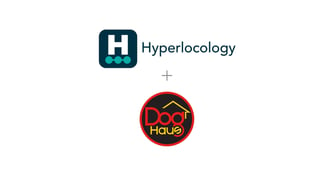As restaurant brands and their franchisees face slowing sales and unrelenting inflation and labor pressures, maximizing the impact of ‘value' messaging to acquire new customers, drive up visit frequency, and increase average check is imperative. However, not all 'value' messages are created equal.
Consumer perception of a value - the benefit gained from using your product (functional, emotional) relative to its costs (monetary, time, energy, etc) - can vary greatly within a region, or between two locations in a single market.
To optimize your value strategy with personally relevant messages that drive results, restaurant brands must consider customizing their value messaging approach on a location-specific basis rather than solely deploying systemwide or regional advertising.
Below we explore the strategic importance of location-specific value messaging, its key drivers, and how to effectively implement this approach across all restaurant locations and franchisees to drive customer acquisition and loyalty.
Understanding the Shift to 'Value' Messaging
In recent years, restaurant customer behavior has shifted significantly, with a growing ease and emphasis on finding the best deals and offers. Economic challenges, such as inflation and reduced disposable income, have prompted customers to extract as much value as possible out of every dollar spent, being conscious of price.
But as Nation's Restaurant News recently reported, "value may be less about price than it ever was before, but it is baked into the set of expectations that a consumer has about a foodservice experience based on the occasion."
To maintain market share in this delicate environment, restaurant marketers have responded by significantly increasing emphasis on value in their marketing messages. Traditionally, tactics have included Power Price Points, BOGOs, Limited Time Offers, Bundles, Loyalty and In-App Offers, Free Delivery, and Personalized Discounts based on a customer's purchase or browsing history.
But in an omnichannel environment, restaurant brands have become even more sophisticated, leveraging technology in their quest to clearly communicate a great benefit while conveying ease-of-purchase. Examples include:
- Flash Sales on Mobile Apps: Deeper discounts during traditionally slow parts of the day, or days of the week.
- Multi-Channel Bundling: Restaurants offer free beverages on any pickup order placed online.
- Point-Of-Interest Offers: Incentives given when a customer is known to be near a brand's location, or near a competitor location.
- QR Code Promotions: Driving consumers to your owned digital assets by placing codes on packaging and print materials.
- Digital Wallet Promotions: Discounts or cashback when using a specific digital wallet or payment app.
- Exit Offers: Post-purchase incentives to revisit in a short period of time, or refer a friend.
Even with new and inventive offer types, the effectiveness of value messaging at the individual location level varies widely based on regional and local competitive dynamics and economic conditions, demographics and cultural preferences, and location-specific performance trends. The value approach that works in one area may not resonate in another, highlighting the need for a more tailored approach.
Furthermore, for discount or promotional messaging to work, it must be supported with highly-effective advertising. "You need to turn up media support behind those deals...and it will take time for that value to resonate, consumers don’t come running back" said an industry leader in a recent AdAge feature.
The Case for Localization of Value Messaging
Expanding the appeal and effectiveness of value messaging across different regions requires an understanding of the nuanced differences that can impact customer-specific perception and behavior. Here are ten compelling reasons why restaurant brands should consider localizing their value messaging:
External Drivers
- Degree of Competition
- The density of competitive locations in a trade area (ie. restaurants per capita) varies widely by location, especially if drilling down to your specific product type. A high concentration of competitors may require a greater mix of value messaging, and/or more aggressive offers.
- Competitor Activity
- Large national brands are not immune from creative promotions from local competitors. Having localized promotional advertising ready to run when this occurs can minimize sales loss. The same reactive ability is a benefit when a new competitor enters the trade area, or to conquest customers from a competitor who closes.
- Wages and Employment
- Although the minimum wage is set at the state level, the 'relative living wage' (county level) is a better indicator for how wage rates and cost-of-living is impacting disposable income. Combine this with local employment trends (large employers entering a trade area, or local layoffs impacting your neighborhoods) to get a full view off potential need for value advertising in the near term.
- Demographics
- Trade areas with softening population, housing affordability or income trends may need to be more aggressive with their value messaging strategy vs. locations in the same market.
- Market Penetration
- When aggregating multi-channel purchase behavior at the individual customer level, you can pair that with publicly available data to determine what % of the trade area population has visited a specific restaurant over certain time spans. Compare this data with that of every location in your system, and you'll identify the locations that need value messaging that helps acquire new customers vs. locations that should seek more visits from existing customers.
Internal Drivers
- Performance Trend
- High vs. Low Volume Stores
- Aggressive systemwide discounting creates trade down - or negative product mix (PMIX) shift - in high volume locations that usually boast strong average check. Allow these strong performers to pull other value levers like bundles, convenience or in-app discounts, Use the more aggressive price-point offers at locations that need immediate traffic stimulus.
- Order Mode Emphasis
- In today's environment, restaurant and retail incentives can be laser targeted to support the method of order (walk-in, web, mobile app, 3rd party) that each location can service most effectively. Brands can also select a specific fulfillment method for an offer (walk-in, curbside pickup, immediate delivery, schedule for future, or any/all) that is most beneficial for their business and frictionless for the customer.
- Service Reputation
- Acquiring a new customer with the value message that resonates best with that individual maximizes the likelihood of a positive experience, and increases the odds of return visits, online reviews, and positive word-of-mouth (for that location, which also benefits other local operators).
- Daypart Growth Needs
- Every restaurant has available capacity at some time of the day, and inventory in a category or two they are eager to minimize. Location-specific value messages based on the most advantageous time-of-day and relevant menu products maximize systemwide sales gains and reduce holding costs.
Download the High-Res Infographic PDF!
The Outcomes:
✅The Most Relevant Value Message
✅To Each Individual Customer
✅Via the Optimal Local Channel and Time
Hyperlocology can unlock all 10 of these benefits for your restaurant brand and franchisees. Take the Product Tour.
So What Now?
- Current and Accessible Customer Data (1PD) and Market Intelligence
Utilize data analytics to understand regional and local demographics, consumer behavior, and purchasing patterns. This data can inform more targeted and relevant value propositions that resonate with local audiences.
- Assess System and Regional Value Messages for Localization
Find the right balance of national brand and value awareness, and localized and personalized value execution, to optimize performance.
- Customized Offers and Promotions
Leverage existing customer data to develop promotions and offers that are specifically designed for local markets and can be deployed at a moment's notice. This might include special pricing, limited-time offers, or bundled deals that align with local preferences and demand. Hyperlocology's platform enables hyperlocal targeting to custom audiences.
- Localized Media and Advertising Channels
Choose the media and advertising channels that are most effective in reaching the value target in each location. Unique personalization is best deployed in select channels, but many approaches can start by testing a broad mix of media and optimizing at the local level.
- Feedback and Continuous Improvement
Regularly collect feedback from local customers to refine and optimize value messaging strategies (ex. input on the quality, taste and price of a limited time product special). This ongoing dialogue ensures that the offers remain relevant and appealing, maximizing future consideration and repeat visits.
Ready to see the location-based marketing experience on Hyperlocology?


-1.png?width=1750&height=875&name=Hubspot%20Blog%20Size%20(6)-1.png)


